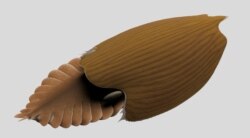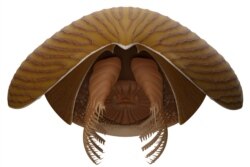About 506 million years ago, a strange sea creature swam in warm waters on the ocean floor off the coast of present-day Canada. At that point in time, it was one of Earth's largest hunters.
Titanokorys gainesi – or Titanokorys, for short – is an arthropod from the Cambrian geological period. Titanokorys lived during a time when much of present-day North America was below warm seas.
On September 8, scientists announced the discovery of its fossils in the Canadian Rockies. The area where it was found is known to be rich in Cambrian fossils.
The name Titanokorys means "titanic helmet" -- and for good reason. Titanic means very large. Helmet is a hard hat you wear on your head. And this creature's “helmet” or head shell made up about two-thirds of its 50-centimeter-long body.
While that may not sound very big, during the Cambrian Period it was huge.
"Most other life forms were smaller than a human thumbnail at that time. By comparison, Titanokorys was longer than an adult human forearm,” said Jean-Bernard Caron. He is a paleontologist of the Royal Ontario Museum in Toronto. He is also the lead writer of the study that appeared in the publication Royal Society Open Science. He and his team spoke with Reuters news agency about their discovery.
Caron said in its day, Titanokorys was a “giant.” It was also a very strange looking animal. He added, “it could be compared to a giant swimming head since the body was so short …”
The creature was also flat, so it could live on the sea floor.
The eyes of the Titanokorys had many different moving parts. Its circular mouth was lined with triangular tooth-like structures. It had two claws to capture prey. It had gills and a series of flaps on the sides of its body for swimming.
Scientists think the Titanokorys fed on buried prey like worms. It used its claws to dig in the mud to find food. However, its claws did not pick up the prey; instead, they pulled the prey into the mouth.
Joe Moysiuk is a paleontologist at the University of Toronto and the Royal Ontario Museum. He is also co-writer of the study. He told Reuters that when the fossils “were first discovered, they were so unusual looking” that the scientists were not sure what kind of animal they belonged to.
He added that because of their strange shape, scientists in the field call them “the mothership.” They use this description because the creature looks something like an unusual spaceship.
The recent fossil discovery is not the first. Scientists discovered parts of fossils of many Titanokorys individuals in Canada’s British Columbia between 2014 and 2018.
The Cambrian period
The Cambrian Period was from about 542 million to 488 million years ago. It was an important time in the history of life on Earth.
During the Cambrian Period, many major animal groups first appeared on Earth. Because such a great amount of life appeared in such a short amount of time, scientists call this time period “Cambrian Explosion.”
I’m Anna Matteo.
Will Dunham reported this story for Reuters news agency. Anna Matteo adapted it for VOA Learning English. Ashley Thompson was the editor.
________________________________________________
Words in This Story
arthropod – n. any of a large group of animals (as crabs, insects, and spiders) with jointed limbs and a body made up of segments
geological – adj. of or relating to the science that deals with the history of the earth and its life especially as recorded in rocks
fossil – n. something (such as a leaf, skeleton, or footprint) that is from a plant or animal which lived in ancient times and that you can see in some rocks
paleontologist – n. a science dealing with the life of past geologic periods as known from fossil remains
giant – adj. having extremely large size, proportion, or power
claw – n. a body part of an animal (such as a lobster or crab) that is used for gripping and holding things
prey – n. an animal that is hunted or killed by another animal for food
gill – n. an organ (as of a fish) for taking oxygen from water
flap – n. something broad and flat or flexible that hangs loose










